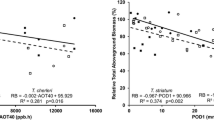Abstract
Evaluation of visual symptoms of ozone damage was conducted in the network of bioindicator rural stations of Catalonia (NE Spain) every 14 days from May to October. Damage rates of ozone (and consequently, ozone biomonitoring capacity of bioindicators) were found to vary highly in time and space depending on the local environmental and meteorological conditions. Lower ozone damage to foliage was produced when meteorological conditions favour stomata resistance. Modulatory effects of meteorological conditions need to be considered in biomonitoring and when modeling plant ozone doses and damage.
Similar content being viewed by others
References
Heggestad, H. E.: 1991, ‘Origin of Bel-W3, Bel-C and Bel-B tobacco varieties and their use as indicators of ozone', Environmental Pollution 74, 264.
ICP-Crops: 1997, Progress Report for the ICP-Crops (International Cooperative Programme on effects of air pollution and other stresses on crops and non-wood plants), pp. 1–71. The Nottingham Trent University.
Krupa, S. V: 1997, Air Pollution, People and Plants. American Phytopathological Society Press, 197 pp.
Krupa, S. V., Manning, W. J. and Nosal, M.: 1993, ‘Use of tobacco cultivars as biological indicators of ambient ozone pollution: an analysis of exposure-response relationships', Environmental Pollution 81, 137.
McKee, D. J. (ed.): 1994, Tropospheric ozone. Human health and agricultural impacts. 333 pp. Lewis Publishers, Boca Raton.
Peñuelas J., Filella I. and Gimeno B. S.: 1995, ‘La fitotoxicitat de l'ozó troposfèric a Catalunya avaluada amb plantes de tabac biosensores', Butll Inst Cat Hist Nat. 63, 133.
Ribas, A., Filella, I., Gimeno, B. S. and Peñuelas, J.: 1998, ‘Evaluation of tobacco cultivars as bioindicators and biomonitors of ozone phytotoxical levels in Catalonia', Water, Air, and Soil Pollution. In press.
Samuelson, L. J. and Kelly, J.M.: 1997, ‘Ozone uptake in Prunus serotina, Acer rubrum and Quercus rubra forest trees of different sizes', New Phytologist 136, 255.
Taylor, G. E. Jr. and Hanson, P. J.: 1992, ‘Forest trees and tropospheric ozone: role of canopy deposition and leaf uptake in developing exposure-response relationships', Agriculture, Ecosystems and Environment 42, 255.
Thorne, L. and Hanson G. P.: 1972, ‘Species differences in rates of vegetal ozone adsorption', Environmental Pollution 3, 303.
Willmer, C. and Fricker M.: 1996, Stomata. 375 pp. Chapman and Hall, London.
Rights and permissions
About this article
Cite this article
Peñuelas, J., Ribas, A., Gimeno, B. et al. Dependence of Ozone Biomonitoring on Meteorological Conditions of Different Sites in Catalonia (N.E. Spain). Environ Monit Assess 56, 221–224 (1999). https://doi.org/10.1023/A:1006062613552
Issue Date:
DOI: https://doi.org/10.1023/A:1006062613552




